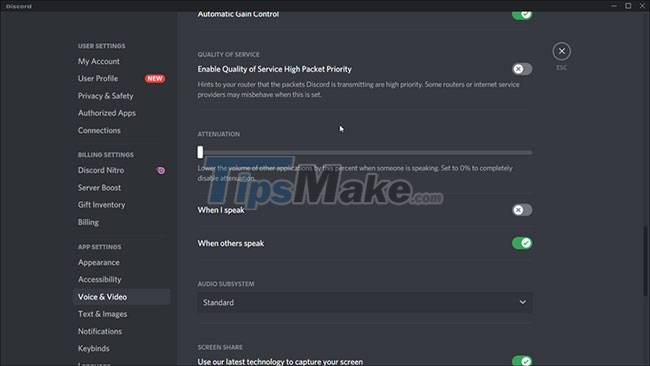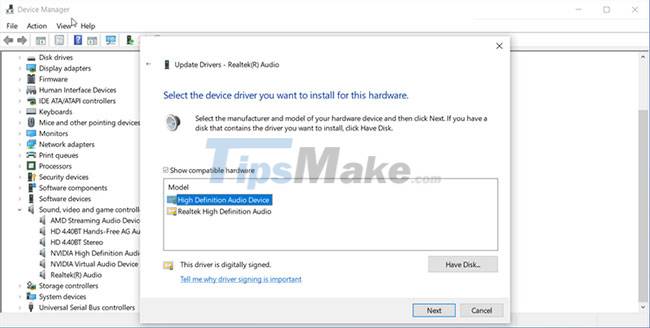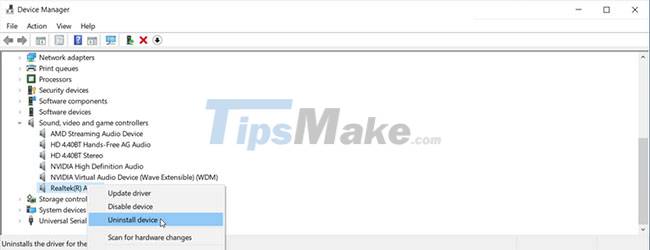Steps to fix volume automatically increase/decrease in Windows 10
Fortunately, you can fix this problem with the ways that Tipsmake suggests below!.
1. Run Windows Audio Troubleshooter

Windows 10 comes with a dedicated audio troubleshooter that you can access from Settings. Run the troubleshooter and it will automatically find and fix audio-related problems for you.
To run the Windows sound troubleshooter:
Step 1: Press Windows key + I to open Settings. Then go to Update & Security section .
Step 2: In the left pane, open the Troubleshoot tab . Then in the right pane, scroll down and check if there is a troubleshooter available. Otherwise, click Additional troubleshooters.
Step 3: In the Additional troubleshooters window that appears, click the Playing audio option .
Step 4: Click Run the troubleshooter to launch the Windows audio troubleshooter. It will immediately scan the system for potential audio problems.
Step 5: If you have multiple audio devices connected, select the affected device and click Next.
Step 6: Follow the on-screen instructions and apply any of the suggested fixes. Once applied, connect the device and check if the problem of automatic volume up/down in Windows is resolved.
2. Turn off effects and sound enhancement options

Realtek audio driver comes with enhanced features added. It allows you to fine-tune bass enhancement, headphone virtualization, and volume equalization options. However, these enhancements can cause the system volume to change without user intervention.
Turning off all such enhancements can help with volume related problems on your system.
To turn off the sound enhancement features do the following:
Step 1: Right-click the speaker icon on the taskbar (at the bottom right corner) and select Sounds.
Step 2: In the Sound window , open the Playback tab .
Step 3: Locate and right-click the affected device, such as a headset, and select Properties.
Step 4: In the Properties window , open the Enhancement tab . Check the Disable all enhancements box .
Step 5: Click Apply > OK to save the changes.
Step 6: Reconnect the headset to the computer and check if there is any improvement.
3. Disable automatic communication

By default, Windows is configured to adjust the volume of different sounds when you receive or make phone calls. This handy feature can also cause your system to misinterpret incoming audio connections.
You can disable the option to communicate in Sound to prevent Windows from changing the system volume. Here's how to do it.
Step 1: Press Windows key + R to open Run. Enter mmsys.cpl and click OK.
Step 2: In the Sound window , open the Communications tab .
Step 3: Select Do nothing and click Apply > OK to save the changes. That will disable communication activity detection on Windows systems.
While effective, this is only an alternative. However, if you don't use your system to receive or make calls, you won't be affected much.
4. Check for hardware conflicts and third-party apps

Armory Crate by Asus and Discord are some popular apps that can change your sound settings. Close all third-party applications you may be running and check if the sound continues to change.
Open Asus Armory Crate and delete all the apps associated with your profile.
On Discord , go to Settings and open the Voice and Video tab . Next, scroll down to the Attenuation section and drag the slider to 0% to turn off the feature.
Also, check the peripherals for hardware problems. Faulty devices, like a wireless mouse or headset adapter, can also cause this problem.
5. Update the audio device driver in Device Manager

Outdated or damaged audio device drivers can cause the audio control system to malfunction. If you think the problem is caused by a driver error, you can update it from Device Manager.
To update the audio device driver, do the following:
Step 1: Press Windows key + R to open Run , type devmgmt.msc and click OK to open Device Manager.
Step 2: In Device Manager , expand Sound, video, and game controllers section . It will display a list of audio devices installed on the system.
Step 3: Next, right-click on the affected audio device and select Update Driver.
Step 4: Select the option Search automatically for the drivers . Windows will scan for available new drivers and install them automatically.
Also, check the audio driver vendor's website for driver updates that aren't available in the Windows download catalog.
6. Restore audio device driver

Device driver updates often improve performance and fix bugs. However, new updates can also bring problems. If you recently updated your audio device driver, try restoring to an earlier version.
To restore the audio device driver, follow these steps:
Step 1: Type device manager into the Windows search bar and open the app from the search results.
Step 2: In Device Manager , expand Sound, video, and game controllers section .
Step 3: Right-click the device and select Properties.
Step 4: Open the Driver tab and click Roll Back Driver . Follow the on-screen instructions to complete the restore process.
7. Downgrade to Windows shared drivers

If you determine the problem is caused by the Realtek driver installed on your system, you can downgrade to the Windows multi-device audio driver. When you switch to a generic driver, Windows removes the additional audio enhancement features provided by Realtek.
To downgrade to a shared Windows driver, do the following:
Step 1: Open Device Manager and expand Sound, video, and game controllers section .
Step 2: Right-click on the Realtek audio device and select Update Driver .
Step 3: Select Browse my computer for driver .
Step 4: Then, select Let me pick from a list of available drivers on my computer .
Step 5: In the driver window, select High Definition Audio Device and click Next.
Step 6: Click Yes to confirm the generic driver installation action. After the installation, restart the PC and check if there is any improvement.
8. Reinstall the audio device driver

You can reinstall your audio driver to fix any temporary problems. Windows will automatically reinstall the necessary drivers during reboot.
To reinstall the audio device driver, do the following:
Step 1: Press Windows key + X , then click Device Manager from the WinX menu .
Step 2: In Device Manager , expand Sounds, video, and game controllers .
Step 3: Right-click on Realtek High Definition Audio and select Uninstall Device.
Step 4: Click Uninstall to confirm action. Once done, restart your PC. Windows will scan the system for missing drivers and install them automatically.
Good luck with your troubleshooting!
You should read it
- How to increase the microphone volume in Windows 10
- Tips to increase speaker volume on iPhone without software
- How to increase the microphone volume on Windows 11 for the best conversation
- How to Change the Volume on a Mac
- 3 Ways to increase, decrease the volume for Video
- Fix the Unmountable Boot Volume error on Windows 10
- How to increase laptop volume in Windows 10
- 7 ways to fix low volume in Windows 10
May be interested
- 7 best free volume booster software for Windows
 sometimes, the maximum volume your speakers provide just doesn't seem to be enough. or perhaps your headphones have a problem, making the sound barely audible.
sometimes, the maximum volume your speakers provide just doesn't seem to be enough. or perhaps your headphones have a problem, making the sound barely audible. - Fix Extend Volume of hidden C drive extremely effectively
 extend volume drive c is hidden is a common situation when the free space of the memory is corrupted. see the steps to fix the extend volume error now.
extend volume drive c is hidden is a common situation when the free space of the memory is corrupted. see the steps to fix the extend volume error now. - How to increase the microphone volume in Windows 10
 if you find that people often complain about not being able to hear your voice during meetings, then the culprit is most likely due to the volume of the microphone pc. fortunately, it's easy to increase the microphone volume in windows 10.
if you find that people often complain about not being able to hear your voice during meetings, then the culprit is most likely due to the volume of the microphone pc. fortunately, it's easy to increase the microphone volume in windows 10. - How to change the volume of Siri on the HomePod
 the homepod and homepod mini speakers are designed to automatically adjust the volume of the siri virtual assistant based on the ambient sounds, but you can completely adjust the volume of siri separately from the music player running.
the homepod and homepod mini speakers are designed to automatically adjust the volume of the siri virtual assistant based on the ambient sounds, but you can completely adjust the volume of siri separately from the music player running. - What is Search volume? Why care about search volume?
 search volume (keyword search volume) refers to the number of searches for a certain keyword within a selected time frame (usually 1 month). in most keyword research tools, the number of searches is an average value based on the past 12 months.
search volume (keyword search volume) refers to the number of searches for a certain keyword within a selected time frame (usually 1 month). in most keyword research tools, the number of searches is an average value based on the past 12 months. - Fix the Unmountable Boot Volume error on Windows 10
 unmountable boot volume error occurs because some installation software conflicts with the operating system or because the computer suddenly shuts down, etc. in the article below, network administrator will show you some ways to fix this error.
unmountable boot volume error occurs because some installation software conflicts with the operating system or because the computer suddenly shuts down, etc. in the article below, network administrator will show you some ways to fix this error. - How to increase laptop volume in Windows 10
 the following simple methods will help you solve the low volume issue in windows laptops forever. use these fixes to increase the volume of your laptop in windows 10.
the following simple methods will help you solve the low volume issue in windows laptops forever. use these fixes to increase the volume of your laptop in windows 10. - How to Change Volume on Mac
 to mute, decrease, or increase the volume on your mac, you need to press the f10, f11, or f12 key (in order). to enable the volume slider in the menu bar, click the apple icon → system preferences → sound → check the box for 'show volume in menu bar'. ). you can also change the volume using the keyboard keys or the oled touch bar.
to mute, decrease, or increase the volume on your mac, you need to press the f10, f11, or f12 key (in order). to enable the volume slider in the menu bar, click the apple icon → system preferences → sound → check the box for 'show volume in menu bar'. ). you can also change the volume using the keyboard keys or the oled touch bar. - How to Set Volume Limit: iPhone Feature That Keeps You From Being Startled by Loud Media Sounds
 when the volume is set too high, the sound can startle you as soon as any media content starts playing. luckily, you can prevent this.
when the volume is set too high, the sound can startle you as soon as any media content starts playing. luckily, you can prevent this. - How to increase the microphone volume on Windows 11 for the best conversation
 i will show you how to increase the microphone volume on windows 11 so that you can fix the situation that your microphone is too small even though the microphone volume is maximized on the software.
i will show you how to increase the microphone volume on windows 11 so that you can fix the situation that your microphone is too small even though the microphone volume is maximized on the software.










 Steps to fix PrintNightmare vulnerability on Windows 10
Steps to fix PrintNightmare vulnerability on Windows 10 Steps to switch to 5GHz WiFi band on Windows 10
Steps to switch to 5GHz WiFi band on Windows 10 Windows 10 update KB5003636 causes a series of serious problems
Windows 10 update KB5003636 causes a series of serious problems How to find hard drive serial number on Windows 10
How to find hard drive serial number on Windows 10 Steps to fix dual boot option not showing in Windows 10
Steps to fix dual boot option not showing in Windows 10 Steps to Fix 'There Are Currently No Power Options Available' error on Windows 10
Steps to Fix 'There Are Currently No Power Options Available' error on Windows 10